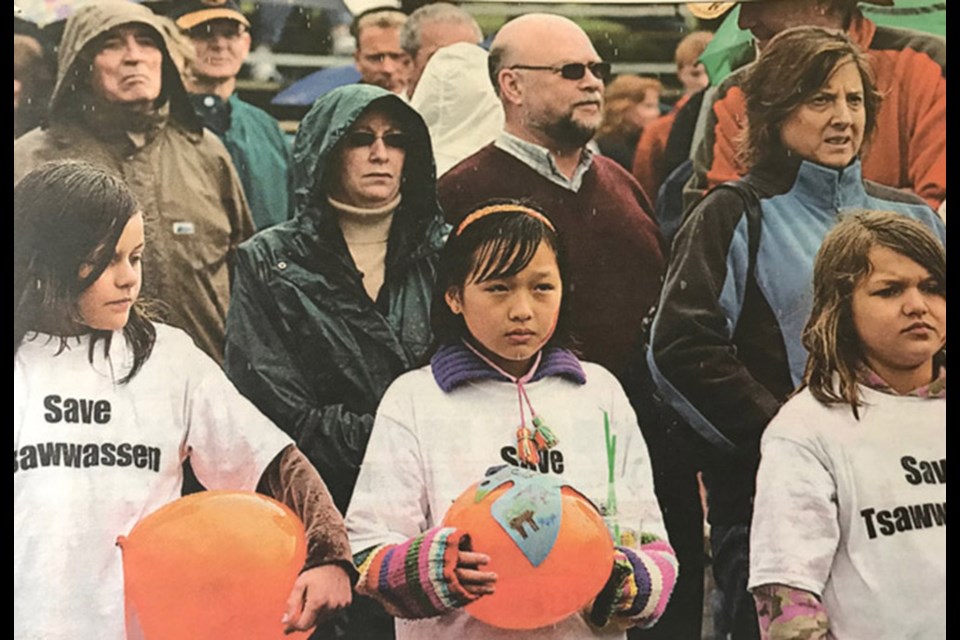This year will mark 15 years since they’ve been buzzing overhead in Tsawwassen and East Ladner.
The B.C. Transmission Corporation’s contentious plan to upgrade existing power lines through a right-of-way in 2008 caused much anger and turmoil, with many of the Tsawwassen homeowners under the power lines eventually taking advantage of a purchase offer and moving away.
The project would see existing 138 kilovolt (kV) power lines replaced with new lines capable of carrying 230 kV. The upgrade along the 3.7-kilometre Tsawwassen segment involved the replacement of 78 wood poles with 20 taller steel towers.
After several years of bitter opposition by residents, including the groups Tsawwassen Residents Against Higher Voltage Overhead Lines (TRAVHOL) and Mothers Against Power Poles (MAPP), the provincial government in the summer of 2008 issued a final blow by saying that work would proceed through the right-of-way as originally planned.
“While there is no need to create a panic on existing lines, it is essential that regulations and guidelines be established immediately requiring transmission companies to route new lines to minimize the effect on residences, schools and public gathering areas,” TRAVHOL urged Health Minister Ujjal Dosanjh three years earlier.
However, alternatives would not be pursued, and the work commenced in June of that year in order to service future power needs of Vancouver Island.
Energy Minister Richard Neufeld at the time released the results of two studies he commissioned which concluded the cost to bury power lines in a method known as horizontal directional drilling was significantly higher than figures quoted by TRAVHOL.
For months, there were protests as well as court action taken by residents, concerned about the potential health impacts of exposure to higher electromagnetic fields (EMF), who tried to block work crews from accessing their properties.
During construction, BCTC said it had to bring in additional security guards to make sure work crews and equipment stayed safe. The transmission corporation claimed there were continued acts of vandalism and workers being threatened by protesters.
A community rally was held in May of 2008 on the grounds of South Delta Secondary. Over 2,000 attended that event, which was originally to be focused solely on the power line issue but became a larger protest about a multitude of issues impacting Delta.
In the end, the project was completed with one of the lines now operating at 230 kV, and has been since the project was commissioned in 2008. The second continues to operate at 138 kV.
BC Hydro continues to say that Health Canada and the World Health Organization position that EMF isn't linked to adverse health effects hasn't changed, despite ongoing research on the topic, and scientific knowledge in the area is now more extensive than for most chemicals.
Due to the intense backlash at the power line construction, the government ended up agreeing to buy back over 100 homes from residents on the right-of-way, renovating and putting them back on the market. It didn’t take long for the buyout program to see all of them resold.
In 2011, Jake Moldowan, the realtor in charge of the sales, explained that while buyers had come from all over the Lower Mainland, a large number came from Richmond.
"They felt they were a good, solid home. They were priced at market and some of the homes moved quite quickly while some of the homes, it took three or four of five months to sell. It depended on getting the right buyer at the right time," said Moldowan, a former president of the Real Estate Board of Greater Vancouver, in an interview at the time.
The contentious power line project, on another front, played a big role in changing the political landscape of South Delta.
In 2009, former city councillor Vicki Huntington was approached by a group of frustrated residents including members of TRAVHOL to run as an independent MLA.
They formed a vigorous constituency association which helped the outspoken independent defeat the Liberals in two straight elections, making B.C. history.




